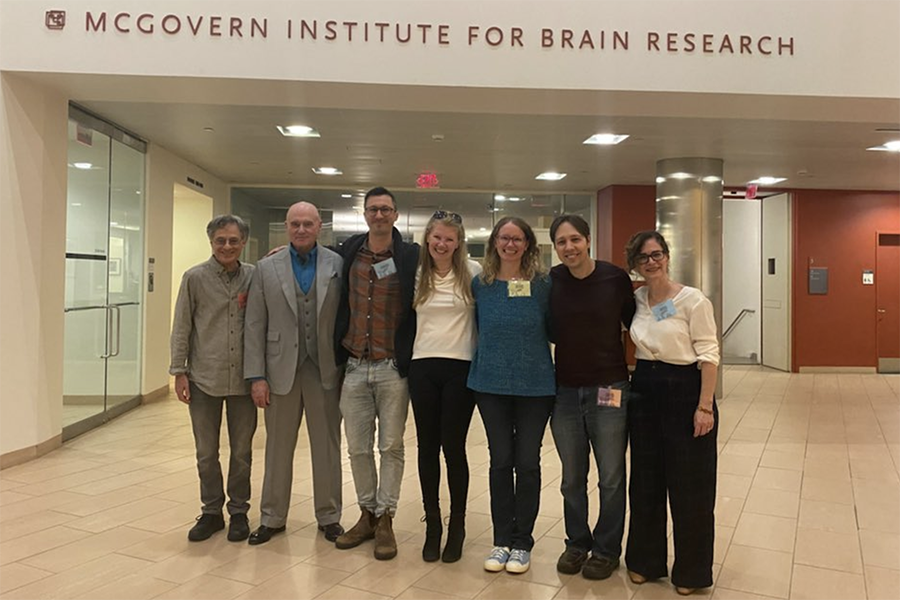Brains on conlangs
Constructed languages like Klingon and Esperanto activate the same parts of the brain that process languages that evolved naturally.

The constructed languages spoken by attendees had all been created for specific purposes. Most, like the Na’vi language spoken in the movie Avatar, had given identity and voice to the inhabitants of fictional worlds, while Esperanto was created to reduce barriers to international communication. But despite their distinct origins, a familiar pattern of activity emerged when researchers scanned speakers’ brains. The brain, they found, processes constructed languages with the same network of areas it uses for languages that evolved naturally over millions of years.
The meaning of language
“There’s all these things that people call language,” Fedorenko says. “Music is a kind of language and math is a kind of language.” But the brain processes these metaphorical languages differently than it does the languages humans use to communicate broadly about the world. To neuroscientists like Fedorenko, they can’t legitimately be considered languages at all. In contrast, she says, “these constructed languages seem really quite like natural languages.”
The “Brains on Conlangs” event that Fedorenko’s team hosted was part of its ongoing effort to understand the way language is generated and understood by the brain. Her lab and others have identified specific brain regions involved in linguistic processing, but it’s not yet clear how universal the language network is. Most studies of language cognition have focused on languages widely spoken in well-resourced parts of the world—primarily English, German, and Dutch. There are thousands of languages—spoken or signed—that have not been included.

Fedorenko and her team are deliberately taking a broader approach. “If we’re making claims about language as a whole, it’s kind of weird to make it based on a handful of languages,” she says. “So we’re trying to create tools and collect some data on as many languages as possible.”
So far, they have found that the language networks used by native speakers of dozens of different languages do share key architectural similarities. And by including a more diverse set of languages in their research, Fedorenko and her team can begin to explore how the brain makes sense of linguistic features that are not part of English or other well studied languages. The Brains on Conlangs event was a chance to expand their studies even further.
Connecting conlangs
Nearly 50 speakers of Esperanto, Klingon, High Valyrian, Dothraki, and Na’vi attended Brains on Conlangs, drawn by the opportunity to connect with other speakers, hear from language creators, and contribute to the science. Graduate student Saima Malik-Moraleda and postbac research assistant Maya Taliaferro, along with other members of both the Fedorenko lab and brain and cognitive sciences professor Ted Gibson’s lab, and with help from Steve Shannon, Operations Manager of the Martinos Imaging Center, worked tirelessly to collect data from all participants. Two MRI scanners ran nearly continuously as speakers listened to passages in their chosen languages and researchers captured images of the brain’s response. To enable the research team to find the language-specific network in each person’s brain, participants also performed other tasks inside the scanner, including a memory task and listening to muffled audio in which the constructed languages were spoken, but unintelligible. They performed language tasks in English, as well.

Prior to the study, Fedorenko says, she had suspected constructed languages would activate the brain’s natural language-processing network, but she couldn’t be sure. Another possibility was that languages like Klingon and Esperanto would be handled instead by a problem-solving network known to be used when people work with some other so-called “languages,” like mathematics or computer programming. But once the data was in, the answer was clear. The five constructed languages included in the study all activated the brain’s language network.
That makes sense, Fedorenko says, because like natural languages, constructed languages enable people to communicate by associating words or signs with objects and ideas. Any language is essentially a way of mapping forms to meanings, she says. “You can construe it as a set of memories of how a particular sequence of sounds corresponds to some meaning. You’re learning meanings of words and constructions, and how to put them together to get more complex meanings. And it seems like the brain’s language system is very well suited for that set of computations.”




